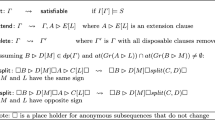Abstract
We introduce a new rule of inference, path resolution, which operates on a graphical representation of quantifier-free predicate calculus formulas. Our goal in the design of path resolution is to retain some of the advantages of both Prawitz analysis and resolution methods, and yet to avoid to some extent their disadvantages.
The main advantage of Prawitz analysis is that, except for variants of original formulas, no new formulas are inferred which rapidly expand the search space. However, except for adding variants, Prawitz analysis is an all or nothing time-bound search for a contradiction. In contrast, resolution and other inference based methods store the progress made at each inference by retaining the inferred formula. Eventually localized evidence of a contradiction is produced, for example the empty clause. The required multiple variants of formulas are automatically (and often excessively) generated. But each new formula introduced interacts with others, expanding the search rapidly in both time and space.
One of the disadvantages of resolution is its reliance on conjunctive normal form. We avoid conjunctive and disjunctive normal form and the duplication of literals that their use may necessitate, since path resolution operates on formulas in negation normal form. We have found that the analysis is greatly simplified by a representation of NNF formulas which we call ‘semantic graphs.’
Path resolution allows Prawitz analysis of an arbitrary subgraph of the existing graphical representation of formulas. If such a subgraph is not large enough to demonstrate a contradiction, a path resolvent of the subgraph may be generated with respect to the entire graph. This generalizes the notions of large inference present in hyper-resolution, clash-resolution, nc-resolution, and UL-resolution.
Preview
Unable to display preview. Download preview PDF.
Similar content being viewed by others
References
Andrews, P.B. Refutations by matings. IEEE Transactions on Computers 25,8 (Aug. 1976), 801–807.
Andrews, P.B. Theorem proving via general matings. JACM 28,2 (April 1981), 193–214.
Bibel, W. On matrices with connections. JACM 28,4 (Oct. 1981), 633–645.
Bibel, W. A Strong Completeness Result for the Connection Graph Proof Procedure. Technical Report ATP-3-IV-80.
Chang, C.L. and Lee, R.C.T. Symbolic Logic and Mechanical Theorem Proving, Academic Press, New York, 1978.
Chang, C.L., and Slagle, J.R. Using rewriting rules for connection graphs to prove theorems. Artificial Intelligence 12 (Aug. 1979), 159–178.
Chinlund, T.J., Davis, M., Hineman, P.G., and McIlroy, M.D. Theorem proving by matching. Bell Laboratory, 1964.
Clark, K. The Synthesis and Verification of Logic Programs. Third Conference on Automated Deduction, August 1977.
Davis, M. and Putnam, H. A computing procedure for quantification theory. JACM, vol. 7 (1960), 201–215.
Davis, M. Eliminating the irrelevant from mechanical proofs. Proc. Symp. of Applied Mathematics 15 (1963), 15–30.
de Champeaux, D. Sub-problem finder and instance checker — two cooperating processors for theorem provers. Proc. 4th Workshop on Automated Deduction, Austin, Texas, Feb. 1979, 110–114.
Gilmore, P.C., A Proof method for quantification theory. IBM Journal of Research and Development, vol. 4 (1960), 28–35.
Henschen, L.G. Theorem proving by covering expressions. J.ACM, 26,3 (July 1979), 385–400.
Kowalski, R. A proof procedure using connection graphs. J.ACM 22,4 (Oct. 1975), 572–595.
McCharen, J., Overbeek, R. and Wos, L. Problems and experiments for and with automated theorem-proving programs. IEEE Transactions on Computers, C-25,8 (Aug. 1976), 773–782.
Murray, N.V. Completely non-clausal theorem proving. Artificial Intelligence 18,1 (Jan. 1982), 67–85.
Murray, N.V. An experimental theorem prover using fast unification and vertical path graphs. Fourth National Conf. of Canadian Society of Computational Studies of Intelligence, U. of Saskatchewan, May 1982.
Murray, N.V. and Rosenthal, E. Semantic Graphs. Technical Report 84-12, Dept. of Computer Science, SUNY at Albany, November 1984.
Nilsson, N.J. A production system for automatic deduction. Technical Note 148, SRI International, 1977.
Prawitz, D. An improved proof procedure. Theoria 26 (1960), 102–139.
Robinson, G.A. and Wos, L. Paramodulation and theorem proving in first order theories with equality. Machine Intelligence 4, 1969, Edinburgh University Press.
Robinson, J.A. A machine oriented logic based on the resolution principle. J.ACM 12,1 (1965), 23–41.
Robinson, J.A. Automatic deduction with hyper-resolution. International Journal of Computer Mathematics, 1 (1965), 227–234.
Robinson, J.A. “Theoretical Approaches to Non-Numerical Problem Solving,” Springer-Verlag, New York, Inc., 1970, 2–20.
Stickel, M.L. A nonclausal connection-graph resolution theorem-proving program. Proc. AAAI-82 Nat. Conf. on Artificial Intelligence, Pittsburgh, Pennsylvania, Aug. 1982, 229–233.
Waldinger, R. and Manna, Z. A deductive approach to program synthesis. ACM TOPLAS 2,1 (1980), 90–121.
Wos, L., Carson, D. and Robinson, G. Efficiency and completeness of the set of support strategy in theorem proving. J.ACM 12,4 (1965), 536–541.
Author information
Authors and Affiliations
Editor information
Rights and permissions
Copyright information
© 1985 Springer-Verlag Berlin Heidelberg
About this paper
Cite this paper
Murray, N.V., Rosenthal, E. (1985). Path resolution and semantic graphs. In: Caviness, B.F. (eds) EUROCAL '85. EUROCAL 1985. Lecture Notes in Computer Science, vol 204. Springer, Berlin, Heidelberg. https://doi.org/10.1007/3-540-15984-3_238
Download citation
DOI: https://doi.org/10.1007/3-540-15984-3_238
Published:
Publisher Name: Springer, Berlin, Heidelberg
Print ISBN: 978-3-540-15984-1
Online ISBN: 978-3-540-39685-7
eBook Packages: Springer Book Archive




